 |
|
 |
WEB EXCLUSIVES |
 |
|
| |
| |
 |
| Cover Story
|
 |
 |
| Textiles’ – the word brings up images of beautiful drapes – cotton, silk, chiffon, lace. Whether it is the material draped on the figurine of the lady... |
|
 |
| |
read more... |
 |
|
 |

|
|
Tapping Sustainable Energy Alternatives
|
|
|
The second lead article, which is also focus article, is written by Shri N Bhadran Nair. Citing a report of the World Health Organisation, the author has advocated for tapping sustainable energy alternatives
|

|

|

|

|
|
Financing Renewables in India
|
|
|
The third article is written by Shri P C Maithani, Adviser, Ministry of New and Renewable Energy. He has focussed on renewable energy resources
|

|

|

|
|
Steps to Achieve India’s Solar Potential
|
|
|
The special article is written by Sumant Sinha, Chairman and Managing Director of ReNew Power. He opines that India must also honour its global commitments on curbing greenhouse gas emissions
|

|

|
|
|
 |
|
|
|
|
| |
Government Vision On Skill Development
Utsav Kumar Singh
October 01, 2015 | Utsav Kumar Singh Web Exclusives>Government Vision , Skill Development
Prime Minister, in his Independence Day speech spoke of his Skill India Mission to promote holistic development, showing very intent on placing renewed emphasis on skill development in the services and manufacturing sectors. Skill development plays a-vital role in improving labour market outcomes and economic growth. World leaders understand the emergent need of skilled development. At the G20 Summit in Brisbane, ILO Director-General Guy Ryder urged G20 leaders to focus on policies that drive growth through more and better jobs.
Indian pattern of employment and productivity reveals important mismatches. Ninety-three per cent of the workforce in India is in informal employment, which suffers from subscale enterprises and overall low productivity. Fifty-eight per cent of the workforce is in agricultural employment that contributes only 15per cent of GDP. It has become a big challenge ahead as it is estimated that only 4.69per cent (NSS,2012) of the total workforce in India has undergone formal skill training as compared to 68per cent in UK, 75 per cent in Germany, 52 per cent in USA, 80 per cent in Japan and 96 per cent in South Korea (UNESCO, 2012).
In recent times with there being a renewed push on existing schemes by the central and state governments, skill development has become a key policy issue, and more importantly, the National Skill Development Mission taking on the ambitious target of skilling and upskilling 500 million people by 2022 in India. To create skill environment, the government announced a National Policy on Skill Development in March 2009 with the framework within which it wanted skills-related training to be conducted and this policy is further succeeded by National Policy for Skill Development and Entrepreneurship 2015.
Finance Minister in his 2015 Budget speech announced the creation of separate Ministry for skill development with fund allocation to the tune of Rs1,543 crore for the financial year 2015-16 that aims to provide an umbrella framework to all skilling activities being carried out within the country, to align them to common standards and link the skilling with demand centers as highlighted in the table below.

Aspiration and Advocacy
There is urgent need of inculcating skills among Indian children and youth and Government of India is working in that direction. Government of India is offering training courses for school drop-outs through a network of more than 5000 Industrial Training Institutes (ITIs) located all over the country. The duration of the training varies from trade to trade and time period ranges from 6 months to 3 years. About 0.75 million training seats are available at the ITIs throughout the country. Over 46,000 seats are exclusively created for the women. Reservation provision for SC/STs, Disabled, OBCs, quotas for Ex-servicemen, etc. has been created has also been made as per Govt. directives received from time to time. Apart from these, at least 25 per cent of all existing institutions of higher education would also offer add-on career oriented courses with specialized skills at an appropriate National Skills Qualifications Framework (NSQF) level within the next five years.
Capacity
The annual skill imparting capacity in the country was estimated at around 7 million in 2014. In the current landscape capacity is being created by private sector training, private and public organizations, industry in house training, government and private Industrial Training Institutes (ITIs), Advanced Training Institutes (ATIs), and in schools, colleges and polytechnics. There is a need for upgrading all existing skill imparting institutions and add new ones. Focus will see a paradigm shift that is from inputs to outcomes of skill training including employability and placements of trainees. Incentives will be linked to placement in all training institutions. State Governments would be encouraged to set up Kaushal Vardhan Kendras (KVKs) at panchayat level with the help of self-help groups (SHG) and Non- Government Organizations (NGOs) for mobilizing and imparting skills pertaining to local employment/livelihood opportunities to school drop-outs, adolescent girls, housewives and rural youth and encourage the innovative approaches that will be adopted to raise the capacity of the system extensively over a limited period with the help.
Quality
In the era of globalized economy, quality of training must be in line of global standards for sustaining the international competitiveness on one hand, as well as improving an individual access to decent employment on the other. 'One Nation One Standard' should be the new mantra to ensure that national standards and quality for skilling are globally aligned and Indian youth can aspire towards securing local, national and international job opportunities. There is need to enhance the quality of trainer by adopting recruiting the experienced and, trained as craft persons and there must be special efforts to improve the gender balance among trainers.
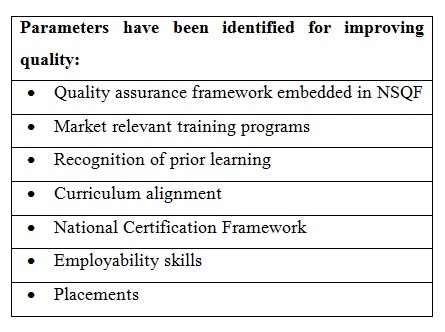
Synergy
MSDE works as umbrella for all skill development programs of various ministries, and has been coordinating skill development efforts in the country, notifying common norms for rationalization of Central Government Schemes on Skill Development. Though, different ministries will be free to frame schemes at their discretion to meet local/sectoral needs while adhering to common norms. Government will also set up a National Labour Market Information System (LMIS) which will provide a socio-economic database.
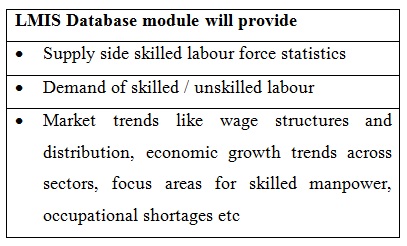
Mobilization and Engagement
Skill Development is a collective responsibility of both the Government as well as the industry. As industry is one of the major stakeholders, it needs to actively participate and contribute to the cause of skill development. Every training provider (TP) including ITIs should tie up with industry in the relevant trades to improve placement opportunities for candidates.
Global Partnerships
Through global partnership, we leverage best practices from the world and enrich our domestic training programs to improve the quality of trainees and trainees. India enjoys the demographic advantage and with the prospect of global shortage of skills as the world population ages, means that country could be supplying skills to the world. As per US Census Bureau estimate, by 2022, countries like USA, UK and China will fall short of skilled labour by 17 million, 2 million and 10 million respectively while India will have surplus skilled workforce of almost 47 million in the age group of 19-59 years.
Outreach
Skill Development Initiative needs considerable amount of expansion of capacity and innovative delivery approaches, and Public Private Partnerships (PPP), KVKs and LMIS will play a pivotal role in identifying local employment opportunities and providing adequate training and post-training support according to needs of local areas such as migration support for skilled workers along with their certified skill levels that can help some of them to move to organized sector. Under the Apprenticeship Training Scheme, around 23,800 establishments are covered and imparting training to 2.58 lakh apprentices and there is an urgent need to revisit the existing Apprentices Act, 1961 to meet the desired target.
ICT Enablement
Information and Communication Technology (ICT) has great potential in connecting people and increasing efficiency. If the skilling process is amalgamated with the tools of ICT, then it can offer twin benefits that are on one side capacity building and capacity enhancing and on the other, leveraging in monitoring of Government schemes related to skill development. Entire ecosystem- from the Government agencies to the training provider and to the last man that is trainee can be connected. Financial transactions can be made possible at click of button and benefits distributed without delay. With the asset of approximately 900 million cell phone users in the country, of which 120 million use smartphones. The Government aims to promote matching online/mobile platform for connecting supply and demand of skilled workers. Private sector will be encouraged to develop mobile applications (apps) for aggregating informal sector workers such as plumbers, carpenters etc. for household services, through innovative commercial models.
Trainers and Assessors
To achieve the massive target of skilling, it is of utmost importance to have quality trainers who are capable of training people in several fields. Similarly, quality assessors in sufficient numbers are also required to ensure consistent outcomes of assessment and certification process. Setting up of Centers of Excellence under the proposed National Skills Universities would also ensure continuous supply of quality trainers in each sector. Special training programs would be developed for training of trainers meant for overseas employment, including language training in collaboration with the concerned country. This could be clubbed together with exchange programs, industry visits and simulated training. MSDE is also planning to provide future livelihood opportunities to the retired government officials specially in defense sector where 50,000 armed forces retire every year with retired personnels’ age ranging from of 35-45.This labour force is a valuable resource and can be utilized as trainer and assessors.
Inclusivity
Government can keep a watch on the implementation of reservation policies and gender composition to promote skill development initiatives that will ensure inclusivity irrespective of gender, location, caste, sector etc. One of the key objectives is to safeguard the skilling needs of marginalized groups viz. Women, SCs, STs, OBCs, minorities, and differently able persons, as well as those living in difficult geographical pockets. Special attention needs to be given to youth residing in North Eastern states, J&K, and the hilly forested areas of central and eastern India regions to address their needs for employment and employability. The government must promote the institutes for entrepreneurship such as Rural Development & Self-employment Training Institutes (RUDSETI).
- Promotion of Skilling among Women:
As per Cencus 2001 report, the female population accounts for 48 per cent of the entire population in India, and have adequate potential to give pace to country’s economy only if their participation in the workforce is increased. With the help of skilling, women can have viable incomes, decent work and thus can turn out to be major players who can contribute equally to the economic growth of the country. Recognizing the value of women empowerment through skill development, government has established one National Vocational Training Centre in Noida and ten regional vocational training institute in Allahabad, Bangalore, Hisar, Indore, Jaipur, Mumbai, Tura, Thiruvananthapuram, Kolkata, Vadodara specially for women. Further, to promote the women’s participation in non-traditional occupations, there is a need to replace the conventional vocational courses with the emerging technological ones.
- Tribal Group
Tribal development has been a challenge to the planners and the policy makers since independence. This is mainly on account of their traditional life styles, remoteness of habitations, dispersed population and displacement. As shown in Table 1.1, tribals constitute 8.6 per cent of Indian population. Total population of STs is 10.45 crore and only 5.1 crore ST persons are workers. The majority of workforce (about 80per cent is engaged in agricultural practices (Census, 2011).
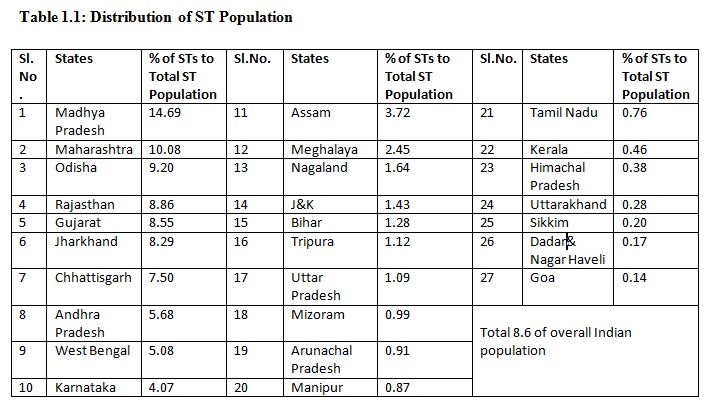
Source: Census of India 2011
These trends underline the need for skill development / vocational training in various trades, ranging from traditional to modern skills, to absorb the drop-outs. Given the majority engagement of ST workers in agro-based activities, there is a need to find innovative solutions to make agriculture sustainable activity. Table 1.2, reveals the allocation of budget for Vocational Training in Tribal Areas and strengthening of Education among ST Girls in Low Literacy Districts.
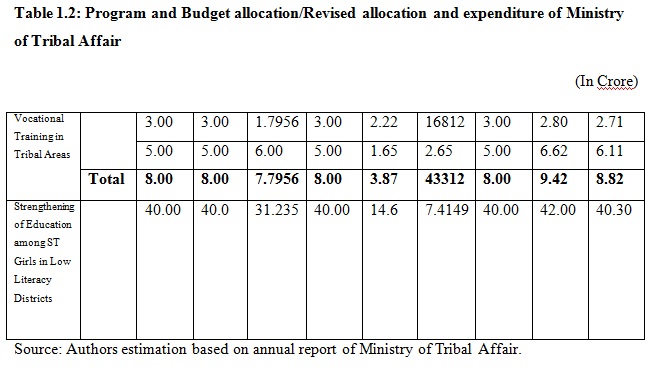
Under the Ministry of Tribal Affair, Government of India launched the Vanbandhu Kalyan Yojana (VKY), on 28th October 2014, mainly focuses on bridging infrastructural gaps and gap in human development indices between Schedule tribes and other social groups. Through VKY, Vocational education and formal technical education are promoted in tribal area and at least 50% of such activities to be oriented for women, such as computer training, office management, hospitality, paramedics, Ayurveda and tribal medicines & medical practices, modern skills etc. through the digital India program, government encourage tribal people to be a part for their skill up gradation and vocational trainings. Through convergence from concerned Ministries / Departments, it is proposed to set up vocational training centre in 206 EMRS and 4477 Ashram Schools, and skill development of 5 Lakh beneficiaries per year.
Scheduled Castes
The National Scheduled Castes Finance & Development Corporation (NSFDC) was set with the objective of financing income generating activities of SC beneficiaries living below Double the Poverty Line limits (presently Annual Family Income Rs.81,000/- for Rural Areas and Rs.1,03,000/- for Urban Areas). NSFDC assist the target group by way of loans, Skill Training, Entrepreneurship Development Programs and Providing Marketing Support through State Channelizing Agencies (SCAs), RRBs, Public Sector Bank & Other Institutions.
NSFDC has an important role to play in skilling people from schedule caste and with consorted efforts along with government, non-government players and industry, there can be remarkable contribution even from the most marginalized. There exists Dalit Indian Chamber of Commerce and Industry which promotes businesses by the people belonging to Scheduled Caste. Being the people engaged in arts and crafts, they are valuable source of traditional knowledge which can be exchanged, assimilated and propagated for maximized returns.
Institutions working for Skill Development
To make this mission successful, three government institutions namely National Skill Development Agency (NSDA), National Skill Development Corporation (NSDC) and Directorate General of Training (DGT) are working with national mission of skill development to facilitate smooth functioning of the national institutional mechanism.
Targeted Areas
Nobel laureate Peter Diamond’s work on search costs in labour markets is very important in the context of emerging economies like India where matching labour demand and supply become difficult because most employment is in the informal sector, largely in agriculture, and the labour force has low levels of education and skills. Diamond points out that just as measured unemployment does not fully reflect the availability of workers to be hired, so too the measured level of vacancies does not fully reflect the availability of jobs (Diamond 2011). The challenges for matching are broad and deep in India.
Thus, we can say that the informal sector, school drop outs youths and adult and seasonal labour force in agriculture are the main target groups for skill development mission. The informal sector in India consists of workers in micro enterprises, unpaid family members, casual labouroers, home based workers, migrant laborers, school drop outs, domestic workers, street vendors, etc. with limited professional skill, low income and low productivity. As per the 66thround of NSS survey (2009-10), approximately 92.8 per cent of the total work force in 2009-10 constituted of informal workers. To strengthen the informal sector government is committed for developing new money-making job skills through education and training. Thus, it is important to train this group to increase their productivity and contribute sustainable economic growth.
School dropout is a global phenomenon of education system among the developing countries. India is also facing the same problem across all the socio-economic class of population. Schedule caste (SC) and schedule tribes (ST) are vulnerable section of the societies, drop out among SC and ST are above the national average. Table 1.1, depict the tribals’ dropout rates which are still very high at 35.6 percent in Classes I to V; 55 per cent in Classes I to VIII; and 70.9 per cent in Classes I to X in 2010-11 and significantly higher than the all India figures.
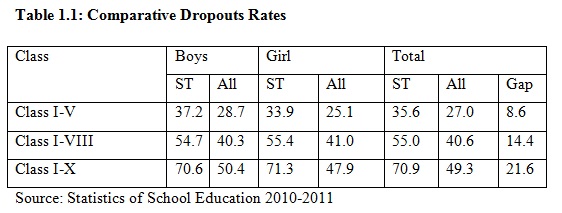
In order to reduce wastage and improve the efficiency of education system, the educational planners need to understand and identify the social groups that are more susceptible to dropout and the reasons for their dropping out. Within the Millennium Development Goals (MDGs) framework, education and training policies play a crucial role in reducing poverty and ensuring an equitable distribution of economic resources.
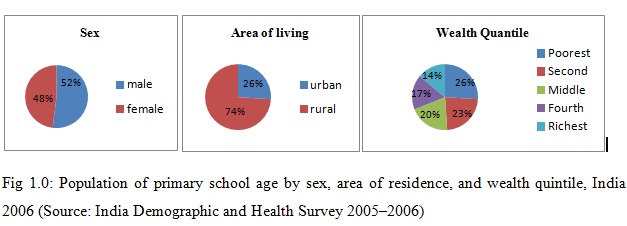
A comparison of the composition of the total population of primary school age and the population of children out of school in India, for instance, shows which groups of children are disproportionately more likely to miss out on education. Figure 1 depicts the composition of the Indian population aged 6–10 years. 52 per cent of all children in this age group are boys, and forty-eight per cent are girls. About one-quarter of all children of primary school age live in urban areas and the remaining three-quarters in rural areas (Hueber, 2007).Absence of skill development courses and lack of employability with present school education has been observed among the poor people quite often. It becomes the ultimate goal of the government to strengthen education system to reduce the school dropout and revisit the school syllabus to make them job oriented by introducing short term, market oriented, demand-driven programs suited to the characteristics and circumstances of the target group.
Conclusion
Government is committed for the skill enhancement program through ‘Skill India Mission’ in order to provide better quality of skill training and reduction in supply demand mismatch by 2022 to achieve the target of skilled work force. MSDE gives umbrella for programs run by different ministries for the promotion of skill development; through the Digital India people of hill area and marginalized section of society are connected to upgrade their skill.
Success of this mission depends on three main factors:
1) Inclusion of marginalized groups as discussed above;
2) Inculcating marketable skills. By marketing skills it not only means emergent domestic market but also the high standards of global market for better contribution to national economy.
3) Creating channels for connecting market and human resource. That includes building on strengths and weeding out weaknesses. These channels would be helpful in imparting market viable skilling, employability of skilled worker (Human Resource) development of marketable products and services and marketing produced products and services.
The channels need to be responsive which can foster tailor-made solutions for changing employment market for maximum returns. This can only happen at behest of government agencies and private players where other actors such as civil society, NGOs, independent institutes and even independent actors are connected.
Market has its own dynamics and imparted skills must cater to that. Now that market is dynamic and keeps evolving, it is important to keep pace with times, This can happen only through proper policy vision. Government on India seems to be committed in that direction and is showing its commitment through various policies and programs.
Reference
- Census of India, 2011. SCHEDULED TRIBES IN INDIA, Census 2011 by Registrar General of India.
- Diamond, P. (2011, June). Unemployment, vacancies, wages. American Economic Review, American Economic Association, 101(4), 1045–1072.
- International Institute for Population Sciences (IIPS) and Macro International. 2007. National Family Health Survey (NFHS-3), 2005–06: India: Volume I. Mumbai: IIPS.
- ILO,2010. Skilled Workforce for Strong, Sustainable and Balanced Growth: A G20 Training Strategy International Labour Office – Geneva.
- Ministry of Tribal Affair, 2014. Convergance Modal on Vanbanhu Kalyan Yojana. Government of India
- MHRD, 2012. Statistics of School Education 2010-2011. Government of India Ministry of Human Resource Development Bureau of Planning, Monitoring & Statistics.
- National Sample Survey (2009-10), “Employment and Unemployment Situation in India (66th Rounds), Ministry of Statistics and Plan Implementation, Government of India, New Delhi.
- National Sample Survey (2011-12). Formal skilling data for working age population from NSSO (68th Round), Ministry of Statistics and Plan Implementation, Government of India, New Delhi.
- UNESCO, 2012; Education at a Glance Report, OECD 2014.

|
|
|
|
|
|
|
|
|
|
 |

|
Regional Languages
|
 |
|
|
 |
|
Regular
Column |
|
J&K Window : |
|
|
|
Do you know? : What is Forensic Auditing |
|
Forensic auditing refers to the auditing with the main aim to employ accounting techniques and methods to gather evidence to investigate the crimes on financial front such as theft, fraud etc.
|
|
|
 |
|
 |
 |